Finding the Sweet Spot | Best Magazines 2017
The transformation of magazines continued apace in 2017, showing signs that some publishers have found the sweet spot within the print-digital mix. Successful strategies include moving to fewer print issues each year, publishing issues with deep dives into single topics, and offering content on a title’s website not available in print. Sports Illustrated will be following this script, announcing in its December 2017 issue that it was moving to biweekly issues that will have 30 percent more pages and be printed on heavier, brighter paper to show off the magazine’s “famous photography.” Often print remains a key component of a publisher’s business model. Such is the case with Harvard Business Review, which sees a strong and continuing role for print in response to the perceived desires of its readers.
MPA—the Association of Magazine Media, an industry trade association, provides some positive data on readership in its most recent Factbook. Between 2015 and 2016, the number of adults who read magazines in digital formats increased by 27 percent. Further, “devoted media usage” of print magazines when compared to the Internet, TV, radio, and newspapers enjoys modest to strong support across generations, even achieving the top score with Gen Xers. And a five-year snapshot of magazine readership by adults shows increases every year between 2012 and 2016, with the largest increase in 2016.
IT’S NOT ALL SWEETNESS
Not all publishers, however, have found the sweet spot for their titles. The sale of Time, Inc., to Meredith late in the year is a reflection of the financial challenges faced by many publishers as they compete with tech behemoths such as Google and Facebook for advertising dollars. As the New York Times reported after the sale, “[Time] failed to keep pace as the industrywide transformation from print to digital rendered old methods of magazine-making obsolete and publishing companies crumbled under the pressure of declines in print advertising and circulation.”
These continuing environmental challenges would seem to ensure yet another year of uncertainty for magazine publishing, with concomitant lists of winners and losers. But as these best publications of 2017 show, publishers and editors are still bringing interesting and quality titles to market. Let’s hope for more of the same in 2018.
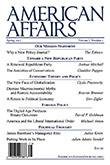 American Affairs. q. $30. Ed: Julius Krein. americanaffairsjournal.org
American Affairs. q. $30. Ed: Julius Krein. americanaffairsjournal.org
The most interesting story line among 2017 start-ups is that of American Affairs. It launched to give “intellectual heft” to Trumpism, according to the New York Times, but founder Krein soured on the president before the end of the summer, making his change of heart public by publishing “I Voted for Trump. And I Sorely Regret It” in the Times. This tack away from a firm embrace of White House policy likely will not dissuade this quarterly from its stated purpose of pushing back on the “neoliberal policy consensus” in Washington. American Affairs is a solid new title and provides a fresh intellectual voice for conservatism.
Anxy. s-a. $40. Ed: Jennifer Maerz. www.anxymag.com
Given the tenor of our national psyche in 2017, the decision to devote the inaugural issue of Anxy to anger was prescient. This issue presents a potpourri of content, from listings of personal phraseology for angry feelings to photojournalism to an analysis of Margaret Atwood’s anger—and much more. As the introductory material makes clear, Anxy is about “exploring personal narratives and mental health through an artful and creative lens.” While this exploration is more shallow than deep, it makes up for it with the breadth of treatment. The first issue is a buffet of anger, with readers quickly getting the sense through the magazine’s design, layout, and content that this is a unique treatment of an all-too-common emotional state.
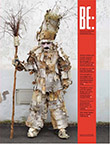 BE: The Journal of the Built Environment Trust. bi-a. $18. Ed: Lewis Blackwell. www.buildingcentre.co.uk/bejournal
BE: The Journal of the Built Environment Trust. bi-a. $18. Ed: Lewis Blackwell. www.buildingcentre.co.uk/bejournal
BE is a beautiful journal, a product of thoughtful and creative design, whose stated goal is to “explore what we need to do to build better.” The magazine looks and feels like quality, and reading its articles confirms these first impressions. A reader needs to know nothing of “circular economies” or “built environments” to take pleasure in reading the inaugural issue. Horace, after all, felt that poetry should “instruct and delight.” BE serves this dual function. A remarkable beginning that holds the potential to enjoy long success.
The Golfer’s Journal. q. $75. Ed: Travis Hill. www.golfersjournal.com
Despite its appeal to weekend duffers, golf has historically been a game for the rich. The Golfer’s Journal is a beautiful quarterly, a substantial new offering filled with exquisite photography, articles on quirky topics (Jimmy Walker’s astrophotography, Ballyneal’s first caddy), and a limited number of high-end advertisements. The Journal will not provide public course denizens with tips on improving their game, but it will afford a glimpse into how the other half live and golf.
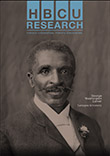 HBCU Research. bi-m. $59. Ed: Sandra Long. hbcuresearch.com
HBCU Research. bi-m. $59. Ed: Sandra Long. hbcuresearch.com
HBCU Research is an attractive and readable bimonthly that celebrates the research accomplishments of historically black colleges and universities. Its premier issue highlights the work of George Washington Carver (1860s–1943). The relatively slim issue includes a dozen short pieces that discuss both current and historical successes at HBCU. Research is a quality initiative, filling an important niche in the landscape of periodicals.
Inks: The Journal of the Comics Studies Society. 3/yr. $80. Ed: Jared Gardner. ohiostatepress.org/inks.html
This new journal of the recently formed Comics Studies Society takes comics seriously, publishing peer-reviewed articles across disciplines. The inaugural issue exemplifies the mission, containing a discussion of African American character types in mid-20th century comics; a roundtable discussion of the methodologies employed in comics research; and regular sections with input from practicing comics professionals and book reviews. Issues will also include a “From the Archives” department that will highlight distinctive collections available in libraries and museums and privately held.
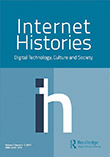 Internet Histories: Digital Technology, Culture and Society. q. $109. Ed: Niels Brugger. www.tandfonline.com/toc/rint20/current
Internet Histories: Digital Technology, Culture and Society. q. $109. Ed: Niels Brugger. www.tandfonline.com/toc/rint20/current
The Internet already has a rich and deep history, four decades in the making. Internet Histories’ founders launched the publication with a view to fostering “the history of the Internet as a field of study in its own right.” This type of scholarly and interdisciplinary treatment of the Internet seems long overdue. The inaugural issue takes on such topics as “Hagiography, revisionism & blasphemy in Internet histories,” “African histories of the Internet,” and “A common language.” As a title from Routledge, covering an important phenomenon central to modern life, Internet Histories may well buck the trend of new journals and enjoy a long and prosperous life.
Nail. q. $20 (issue 1). Ed: Elea Carey. nailthemagazine.com
The opening gambit of Nail conjures up the same sort of lovely disorientation many readers felt when looking through the first issue of Wired back in 1993. Like Wired, Nail feels different. The creative design tickles in the midst of cognitive dissonance. Notably, the title for the main article (“How Do We Survive This Bully?”) spans ten double folds, each harshly colorful with an underlying image of Donald Trump, its political message writ large. Its stated goal is to see how “talented, committed, empathetic people get through the day,” believing such exposition can make “the world a better place.”
Resist! s-a. Free. Eds: Françoise Mouly & Nadja Spiegelman. www.resistsubmission.com
Arising from the “covfefe” of the 2016 election is Resist!, a freely distributed newsprint publication consisting of comics by women artists, with the motto of “Women’s Voice Will Be Heard.” Edited by Mouly, art editor for The New Yorker, and her daughter Spiegelman, a writer, Resist! has the feel and sensibility of a grassroots protest movement, manifested brilliantly in comics of every conceivable style.
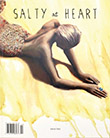 Salty at Heart. s-a. Subs. info upcoming. Ed: Kirstin Thompson. www.saltyatheart.com
Salty at Heart. s-a. Subs. info upcoming. Ed: Kirstin Thompson. www.saltyatheart.com
Salty at Heart is a welcome respite from the contretemps of politics that seems to have overwhelmed contemporary life. The semiannual is a bit difficult to classify. Its stated mission is to “provide a space for women to be heard and valued,” as a publication that “empowers rather than disempowers.” Among its concerns are human rights and environmentalism. The magazine includes beautiful photography, with most pictures depicting women engaged in their pursuits with enthusiasm. Among these are surfing, photographing the River People of the Amazon, running an Auckland café, and living trash-free (and saving the ocean from our plastics). The oceans and waters of the world appear to be the binding agent of this engaging magazine.
RELATED
ALREADY A SUBSCRIBER? LOG IN
We are currently offering this content for free. Sign up now to activate your personal profile, where you can save articles for future viewing









Add Comment :-
Comment Policy:
Comment should not be empty !!!